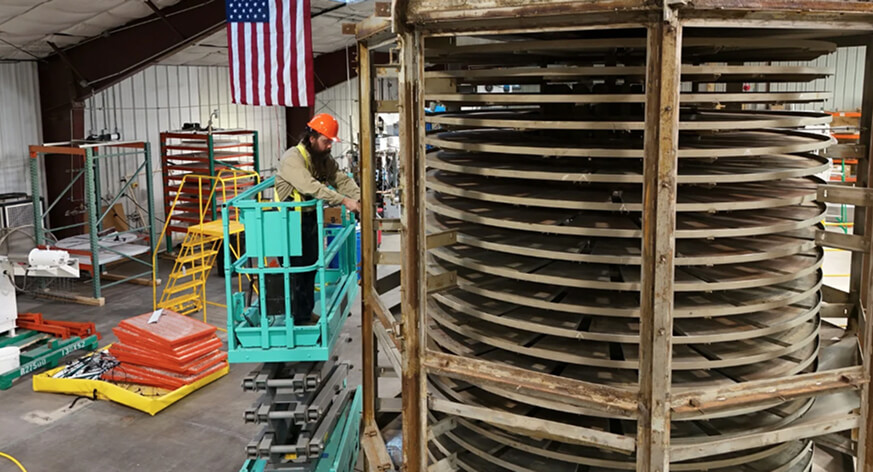
The direct air capture industry is racing toward a transformative milestone: cutting costs from today's $600 per ton to an ambitious $100-150 range by 2050. This isn't just wishful thinking, it's a calculated pathway backed by companies deploying three proven strategies that mirror solar power's dramatic cost decline over the past two decades. The question isn't whether costs will drop, but whether the industry can scale fast enough to matter.
Current DAC systems capture carbon at anywhere from $500 to $1,000 per ton, making them expensive compared to other climate solutions. But industry leaders see a clear roadmap to slash these costs by 75-80%, unlocking commercial viability at climate-relevant scale. The key lies in energy efficiency breakthroughs, mass manufacturing, and hybrid revenue models that are already showing results. These advances come as carbon capture investments across the U.S. reach $77 billion.
>> RELATED: Where the $6.5 Trillion Goes: Carbon Tech Fights for Funding
The Economic Threshold That Changes Everything
Industry analysts agree that crossing below $200 per ton, and ideally reaching $100-150 per ton, represents the tipping point where DAC becomes economically sustainable. Google's recent deal with Holocene at $100 per ton, though subsidized by the 45Q tax credit, demonstrates that this target is achievable, not theoretical. The deal relies on Holocene's innovative chemistry licensed from Oak Ridge National Laboratory and upfront capital from Google to derisk the technology.
The math is straightforward but daunting. To move down the cost curve enough to hit these targets, the industry needs to build roughly 1 gigaton of annual capacity, which requires around $200 billion in investment. This follows a learning curve model where costs drop with each doubling of capacity, exactly as solar photovoltaics did when costs fell 90% over four decades.

Three Pathways Driving Cost Reduction
1. Energy Efficiency Breakthroughs
Energy consumption accounts for the largest share of DAC operating costs, making efficiency gains the fastest path to cost reduction. Phlair's electrochemical approach targets energy use under 1.5 MWh per ton, saving approximately $15 per ton compared to conventional systems. This matters because traditional thermal DAC systems require 2,500 kWh or more, while emerging solid sorbent systems can operate at 1,100 kWh.
The shift to lower-temperature regeneration is equally significant. Phlair's technology eliminates heating entirely through electrochemistry, while others are dropping from 900°C to 100°C regeneration temperatures. Companies like Avnos are pioneering hybrid approaches that capture both CO2 and water from the air, with their system producing five tons of water for every ton of CO2 removed, adding value while cutting costs.
Integration with behind-the-meter renewables provides another cost advantage. When DAC facilities can use excess solar or wind power directly, they avoid grid transmission costs and can operate during periods of cheap electricity. This operational flexibility becomes increasingly valuable as renewable penetration grows.

>> In Other News: Carbon Capture Pipelines Have Struggled To Advance. A Project In Nebraska Found Success
2. Scale and Manufacturing Innovation
CarbonCapture is pioneering mass production of modular DAC systems at its Mesa, Arizona facility, targeting output of 4,000 modules per year when at full capacity. This manufacturing approach, similar to how Tesla scaled electric vehicles, aims to bring manufacturing efficiencies to carbon removal. The company's modular design allows for rapid deployment and standardization, critical factors in driving down per-unit costs.
The scale threshold matters enormously. Facilities capturing under 50,000 tons per year typically remain above $1,000 per ton due to fixed costs spread across limited output. But economies of scale kick in dramatically above 1 million tons per year, where infrastructure, operations, and financing costs can be amortized across much larger volumes. Occidental's STRATOS facility, designed for 500,000 tons annually, represents a major step toward this scale threshold.

"The structure of this partnership, providing immediate funding to achieve an ambitious but important price in the medium term, is just one way to support carbon removal as it scales."
Randy Spock, Carbon Credits and Removals Lead, Google
3. Hybrid Revenue Models
Forward-thinking companies are discovering that DAC facilities don't need to rely solely on carbon removal revenue. Spiritus is integrating power generation with its Orchard Power platform, creating a second revenue stream alongside carbon credits. This hybrid model improves project economics by capturing value from multiple products.

Using DAC-captured CO2 for synthetic fuel production represents another revenue diversification strategy. When co-located with industrial sites producing sustainable aviation fuel or e-fuels, DAC systems eliminate transport costs while providing critical feedstock. The carbon becomes both a removal credit and a manufacturing input, doubling its economic value.
Industrial integration offers operational savings beyond revenue. Facilities located near data centers, manufacturing plants, or power stations can utilize waste heat for regeneration processes, dramatically cutting energy costs. This symbiotic relationship between carbon removal and existing infrastructure makes DAC more practical and affordable. Some companies are exploring integration with hydrogen production facilities, creating multi-product clean energy hubs.

What distinguishes these frontrunners is their willingness to challenge conventional DAC design. Rather than incrementally improving existing approaches, they're reimagining how carbon capture systems should work. Avnos recognized that water scarcity in prime DAC locations was a barrier, so they designed a system that produces water as a valuable byproduct rather than consuming it.
The competitive landscape is intensifying as more players enter with differentiated approaches. Graphyte claims costs under $100 per ton using biomass burial rather than air capture, though this represents a different carbon removal pathway. Their success demonstrates that multiple approaches can coexist, each serving different use cases and price points. As global CCUS capacity expands toward 735 million tonnes annually by 2030, DAC companies are positioning themselves to capture a meaningful share.

"The chemistry from Oak Ridge is special. It's different than all other chemistries, we think, in direct air capture."
Anca Timofte, Co-founder and CEO, Holocene
Policy Frameworks Supporting the Transition
The 45Q tax credit remains the cornerstone of U.S. policy support, providing $180 per ton for DAC projects with geological storage. This credit survived recent policy shifts and continues to derisk early-stage projects by covering a substantial portion of removal costs. When combined with carbon removal purchases at $100-280 per ton, the economics start to pencil out for pioneering projects. Meanwhile, carbon storage infrastructure is rapidly expanding across multiple states.
California's Low Carbon Fuel Standard adds another layer of support, offering approximately $50 per ton for qualified carbon removal. This state-level backing demonstrates that even as federal priorities shift, subnational policies can sustain momentum. Multiple states are developing their own frameworks, creating a patchwork of incentives that help companies reach commercial viability.
Corporate procurement agreements from tech giants like Microsoft, Google, and Meta provide crucial demand signals. These multi-year commitments give DAC developers the financial certainty needed to invest in manufacturing capacity and operational improvements. The Frontier advance market commitment, pooling $1 billion from multiple corporations, represents a new model for catalyzing clean technologies through coordinated purchasing.
Learning from Solar's Success
Solar photovoltaic costs fell over 90% in 40 years through a combination of manufacturing scale, materials innovation, and policy support. DAC is following a similar trajectory, with each project providing operational data that informs the next generation. The critical difference is urgency: climate timelines demand DAC scale faster than solar did, requiring more aggressive investment and deployment to hit the 2050 cost targets that make multi-gigaton removal feasible.
The Path Forward: Optimism Grounded in Reality
The 75% cost reduction pathway isn't guaranteed, but it's grounded in demonstrated principles from other clean technologies. Solar achieved similar drops, wind turbines followed suit, and lithium-ion batteries crashed in price by 97% over three decades. DAC benefits from learning accumulated across all these transitions, plus advances in materials science, computational modeling, and manufacturing that didn't exist for earlier technologies.
What makes the current moment promising is the convergence of multiple cost reduction strategies simultaneously. Companies aren't relying on a single breakthrough but rather on cumulative improvements across energy efficiency, manufacturing scale, and business model innovation. Each percentage point of improvement compounds, creating an accelerating path toward economic viability.
The industry still faces significant challenges, including energy availability, storage infrastructure development, and maintaining policy support across political cycles. But with leading companies demonstrating multiple pathways to cost reduction, the $100-150 per ton target looks increasingly achievable. The race now is to scale fast enough to capture the climate benefits these technologies promise.
Subscribe to the newsletter
Daily decarbonization data and news delivered to your inbox
Follow the money flow of climate, technology, and energy investments to uncover new opportunities and jobs.
Companies
Latest issues
-
Why Two Korean Giants Just Bet Big on US Wood Waste
Inside This Issue 🌲 Why Two Korean Giants Just Bet Big on US Wood Waste 🧪 Primary Hydrogen Identifies 8-kilometre Hydrogen Anomaly at Crooked Amphibolite Project in British Columbia 🚇 Carbon Captu...
-
This Tech Could Rewrite Hydrogen Economics
Inside This Issue ⚗️ ExxonMobil-BASF Partnership Signals Turquoise Hydrogen's Shift From Lab to Industrial Scale 🧱 API Endorses Use of Portland Cement in Carbon Storage Wells 🤝 CCME Engages at the...
-
Tech Breakthrough Turns Salty Waste into Carbon Gold?
Inside This Issue 💧 Ebb Partners with Saudi Water Authority to Transform Desalination Brine into Megaton-Scale CO₂ Removal 🏭 CO280 Successfully Completes Carbon Capture Field Pilot at a U.S. Pulp ...
Company Announcements
-
Getech, a world-leading locator of subsurface resources, has signed a Memorandum of Understanding (MoU) with HyReveal, a French deeptech startup expert in subsurface hydrogen and associated gases, ...
-
IonQ And Heven AeroTech Partner To Develop Quantum-Enabled Drones For National Security Applications
Partnership to integrate IonQ’s quantum technologies into Heven’s long-range, hydrogen-powered drone platform. IonQ’s investment will accelerate the development of quantum-enabled endpoints as it ...
-
Worthy's approach of marrying open-source science and practical tools for industry use Awards will accelerate development and deployment of trusted measurement, reporting, and verification tools n...
-
NW Natural and Modern Hydrogen Unveil Clean Hydrogen Production, Carbon Capture Project in Portland
Innovative methane pyrolysis technology, which is online at NW Natural’s Central Portland facility, produces clean hydrogen and captures solid carbon PORTLAND, Ore. (BUSINESS WIRE) -- NW Natural a...
